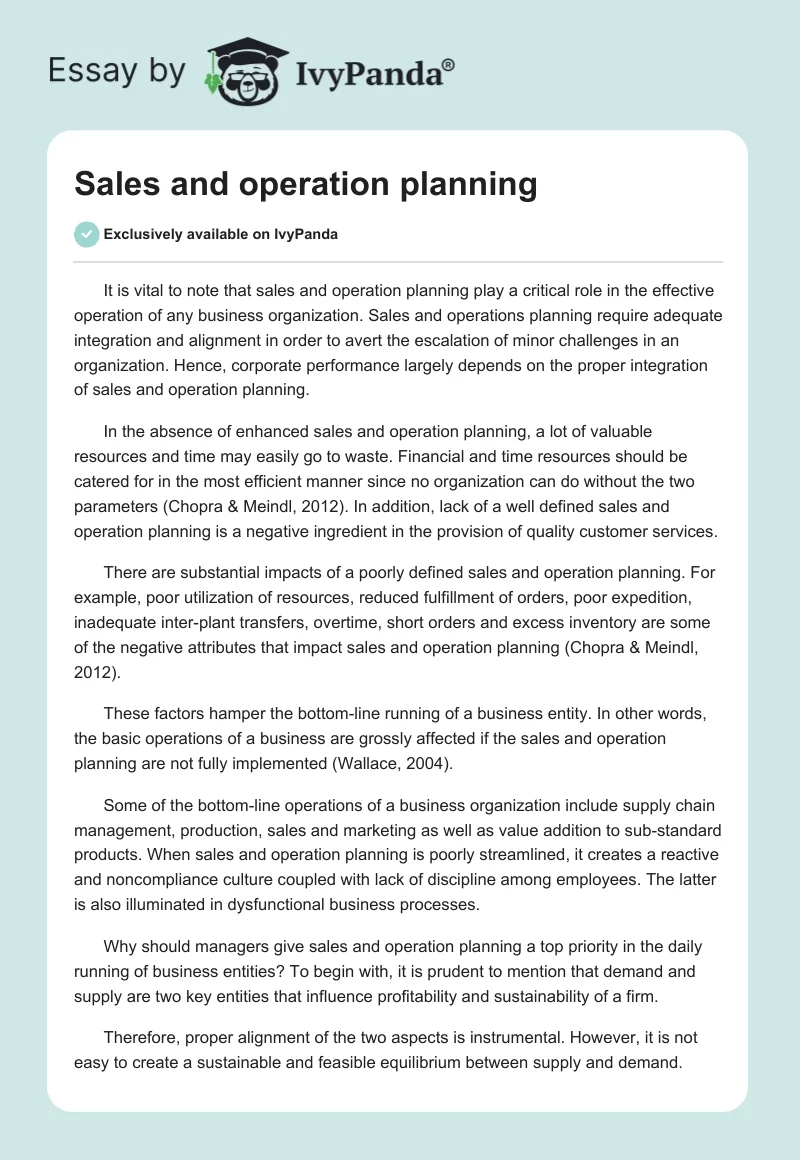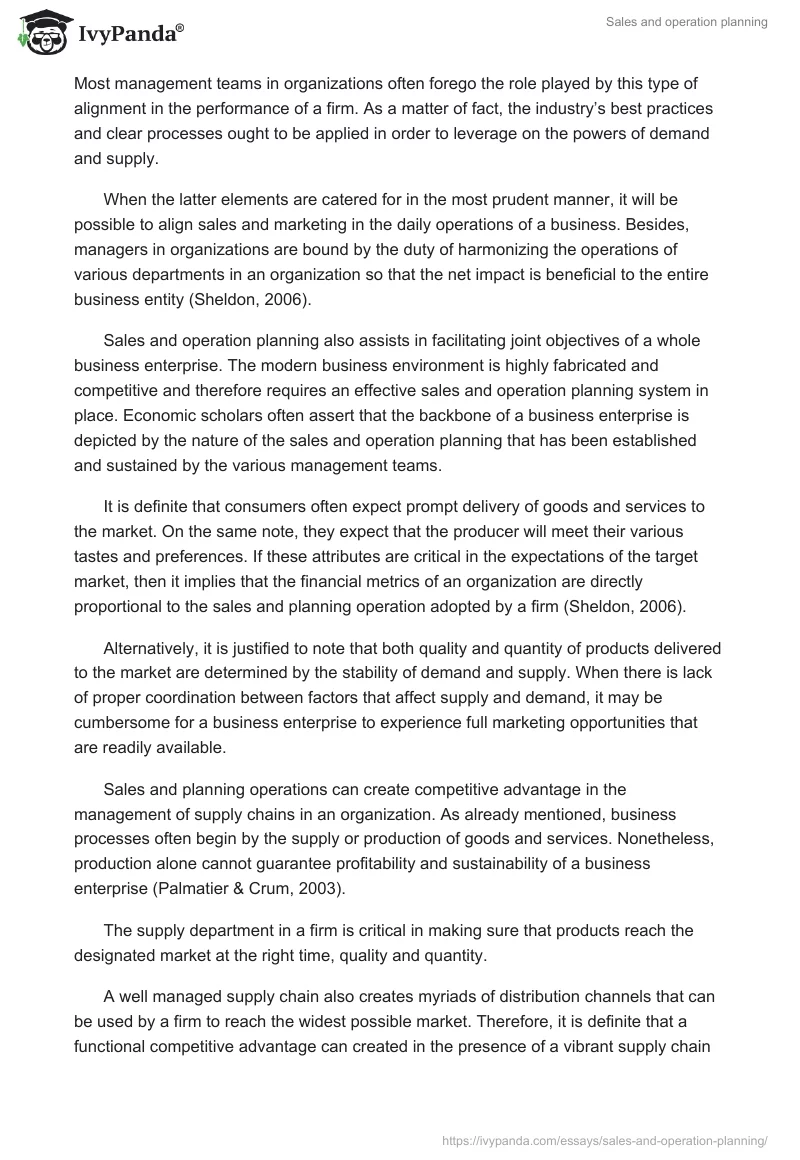It is vital to note that sales and operation planning play a critical role in the effective operation of any business organization. Sales and operations planning require adequate integration and alignment in order to avert the escalation of minor challenges in an organization. Hence, corporate performance largely depends on the proper integration of sales and operation planning.
In the absence of enhanced sales and operation planning, a lot of valuable resources and time may easily go to waste. Financial and time resources should be catered for in the most efficient manner since no organization can do without the two parameters (Chopra & Meindl, 2012). In addition, lack of a well defined sales and operation planning is a negative ingredient in the provision of quality customer services.
There are substantial impacts of a poorly defined sales and operation planning. For example, poor utilization of resources, reduced fulfillment of orders, poor expedition, inadequate inter-plant transfers, overtime, short orders and excess inventory are some of the negative attributes that impact sales and operation planning (Chopra & Meindl, 2012).
These factors hamper the bottom-line running of a business entity. In other words, the basic operations of a business are grossly affected if the sales and operation planning are not fully implemented (Wallace, 2004).
Some of the bottom-line operations of a business organization include supply chain management, production, sales and marketing as well as value addition to sub-standard products. When sales and operation planning is poorly streamlined, it creates a reactive and noncompliance culture coupled with lack of discipline among employees. The latter is also illuminated in dysfunctional business processes.
Why should managers give sales and operation planning a top priority in the daily running of business entities? To begin with, it is prudent to mention that demand and supply are two key entities that influence profitability and sustainability of a firm.
Therefore, proper alignment of the two aspects is instrumental. However, it is not easy to create a sustainable and feasible equilibrium between supply and demand. Most management teams in organizations often forego the role played by this type of alignment in the performance of a firm. As a matter of fact, the industry’s best practices and clear processes ought to be applied in order to leverage on the powers of demand and supply.
When the latter elements are catered for in the most prudent manner, it will be possible to align sales and marketing in the daily operations of a business. Besides, managers in organizations are bound by the duty of harmonizing the operations of various departments in an organization so that the net impact is beneficial to the entire business entity (Sheldon, 2006).
Sales and operation planning also assists in facilitating joint objectives of a whole business enterprise. The modern business environment is highly fabricated and competitive and therefore requires an effective sales and operation planning system in place. Economic scholars often assert that the backbone of a business enterprise is depicted by the nature of the sales and operation planning that has been established and sustained by the various management teams.
It is definite that consumers often expect prompt delivery of goods and services to the market. On the same note, they expect that the producer will meet their various tastes and preferences. If these attributes are critical in the expectations of the target market, then it implies that the financial metrics of an organization are directly proportional to the sales and planning operation adopted by a firm (Sheldon, 2006).
Alternatively, it is justified to note that both quality and quantity of products delivered to the market are determined by the stability of demand and supply. When there is lack of proper coordination between factors that affect supply and demand, it may be cumbersome for a business enterprise to experience full marketing opportunities that are readily available.
Sales and planning operations can create competitive advantage in the management of supply chains in an organization. As already mentioned, business processes often begin by the supply or production of goods and services. Nonetheless, production alone cannot guarantee profitability and sustainability of a business enterprise (Palmatier & Crum, 2003).
The supply department in a firm is critical in making sure that products reach the designated market at the right time, quality and quantity.
A well managed supply chain also creates myriads of distribution channels that can be used by a firm to reach the widest possible market. Therefore, it is definite that a functional competitive advantage can created in the presence of a vibrant supply chain system. For instance, the choice of a distribution channel will determine will determine the time taken for products to reach the desired market.
If a complicated distribution channel is adopted, then it is highly likely that the substitute products from other market rivals will reach the market promptly. Such a scenario will short-circuit the sales opportunities of a competing firm. Moreover, it will eventually hamper the overall operations of a business enterprise due to low sales and stiff competition.
The same sales and operation planning techniques can be applied by VCC in strengthening its market presence and sales options. For example, by aligning the supply and demand forces, it would be possible for VCC to come up with viable options of accelerating production and revamping the current supply chain system (Branch, 2008).
References
Branch, E.A. (2008).Global Supply Chain Management and International Logistics. New York: Routledge.
Chopra, S. & Meindl, P. (2012). Supply Chain Management. New York: Pearson.
Palmatier, E.G. & Crum, C. (2003). Enterprise Sales and Operations Planning: Synchronizing Demand, Supply and Resources for Peak performance. Raton, Florida: Ross Publishing, Inc.
Sheldon, H.D. (2006). World Class sales and operations planning: A guide to successful implementation and robust execution. New York: Apics.
Wallace, F.T. (2004). Sales and Operations Planning: The How-to Handbook ( 2nd Ed.). Cincinnati, Ohio: Wallace & Company.


